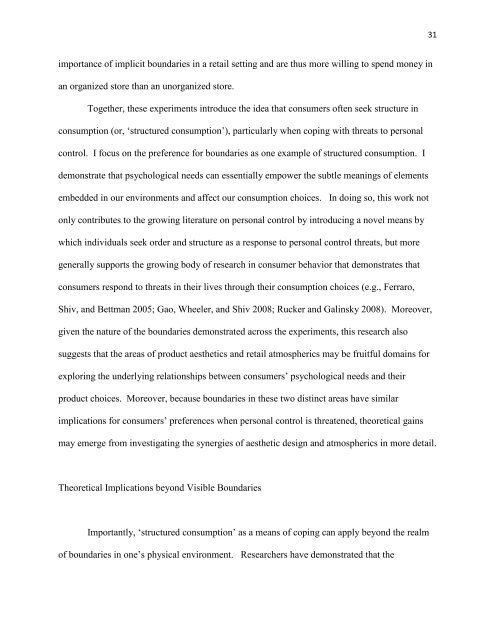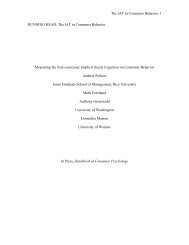The Beauty of Boundaries: When and Why We Seek Structure in ...
The Beauty of Boundaries: When and Why We Seek Structure in ...
The Beauty of Boundaries: When and Why We Seek Structure in ...
- No tags were found...
You also want an ePaper? Increase the reach of your titles
YUMPU automatically turns print PDFs into web optimized ePapers that Google loves.
31importance <strong>of</strong> implicit boundaries <strong>in</strong> a retail sett<strong>in</strong>g <strong>and</strong> are thus more will<strong>in</strong>g to spend money <strong>in</strong>an organized store than an unorganized store.Together, these experiments <strong>in</strong>troduce the idea that consumers <strong>of</strong>ten seek structure <strong>in</strong>consumption (or, ‗structured consumption‘), particularly when cop<strong>in</strong>g with threats to personalcontrol. I focus on the preference for boundaries as one example <strong>of</strong> structured consumption. Idemonstrate that psychological needs can essentially empower the subtle mean<strong>in</strong>gs <strong>of</strong> elementsembedded <strong>in</strong> our environments <strong>and</strong> affect our consumption choices. In do<strong>in</strong>g so, this work notonly contributes to the grow<strong>in</strong>g literature on personal control by <strong>in</strong>troduc<strong>in</strong>g a novel means bywhich <strong>in</strong>dividuals seek order <strong>and</strong> structure as a response to personal control threats, but moregenerally supports the grow<strong>in</strong>g body <strong>of</strong> research <strong>in</strong> consumer behavior that demonstrates thatconsumers respond to threats <strong>in</strong> their lives through their consumption choices (e.g., Ferraro,Shiv, <strong>and</strong> Bettman 2005; Gao, Wheeler, <strong>and</strong> Shiv 2008; Rucker <strong>and</strong> Gal<strong>in</strong>sky 2008). Moreover,given the nature <strong>of</strong> the boundaries demonstrated across the experiments, this research alsosuggests that the areas <strong>of</strong> product aesthetics <strong>and</strong> retail atmospherics may be fruitful doma<strong>in</strong>s forexplor<strong>in</strong>g the underly<strong>in</strong>g relationships between consumers‘ psychological needs <strong>and</strong> theirproduct choices. Moreover, because boundaries <strong>in</strong> these two dist<strong>in</strong>ct areas have similarimplications for consumers‘ preferences when personal control is threatened, theoretical ga<strong>in</strong>smay emerge from <strong>in</strong>vestigat<strong>in</strong>g the synergies <strong>of</strong> aesthetic design <strong>and</strong> atmospherics <strong>in</strong> more detail.<strong>The</strong>oretical Implications beyond Visible <strong>Boundaries</strong>Importantly, ‗structured consumption‘ as a means <strong>of</strong> cop<strong>in</strong>g can apply beyond the realm<strong>of</strong> boundaries <strong>in</strong> one‘s physical environment. Researchers have demonstrated that the




